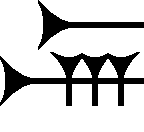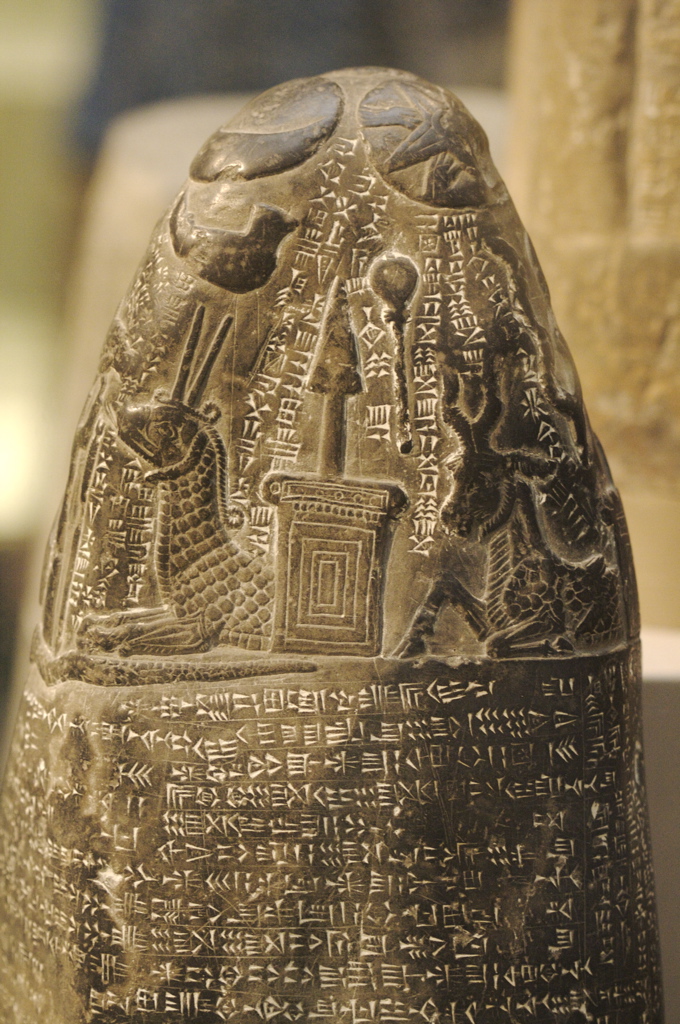|
Amarna Letter EA 288
Amarna letter EA 288, titled ''Benign Neglect,'' is a tall, finely-inscribed clay tablet letter, approximately 7.5 in tall x 4.5 in wide, broken into two pieces, from Abdi-Heba the mayor/ruler of Jerusalem, of the mid 14th century BC Amarna letters. The scribe of his six letters to Egypt were penned by the "Jerusalem scribe"; EA 288 is a moderately long, and involved letter. The Amarna letters, about 300, numbered up to EA 382, are a mid 14th century BC, about 1350 BC and 20–25 years later, Text corpus, correspondence. The initial corpus of letters were found at Akhenaten's city Akhetaten, in the floor of the Bureau of Correspondence of Pharaoh; others were later found, adding to the text corpus, body of letters. Letter EA 288 (also see here-(Obverse), is numbered VAT 1643, from the Vorderasiatisches Museum Berlin. ''A summary of letter structure:'' EA 288 begins with a short address to the Pharaoh. Immediately, 3 segue paragraphs begin the letter, as "dramatic statements" b ... [...More Info...] [...Related Items...] OR: [Wikipedia] [Google] [Baidu] |
Akhenaten
Akhenaten (pronounced ), also spelled Echnaton, Akhenaton, ( egy, ꜣḫ-n-jtn ''ʾŪḫə-nə-yātəy'', , meaning "Effective for the Aten"), was an ancient Egyptian pharaoh reigning or 1351–1334 BC, the tenth ruler of the Eighteenth Dynasty. Before the fifth year of his reign, he was known as Amenhotep IV ( egy, jmn-ḥtp, links=no, meaning "Amun is satisfied", Hellenized as ''Amenophis IV''). As a pharaoh, Akhenaten is noted for abandoning Egypt's traditional polytheism and introducing Atenism, or worship centered around Aten. The views of Egyptologists differ as to whether the religious policy was absolutely monotheistic, or whether it was monolatry, syncretistic, or henotheistic. This culture shift away from traditional religion was reversed after his death. Akhenaten's monuments were dismantled and hidden, his statues were destroyed, and his name excluded from lists of rulers compiled by later pharaohs. Traditional religious practice was gradually restored, not ... [...More Info...] [...Related Items...] OR: [Wikipedia] [Google] [Baidu] |
ARAD (Sumerogram)
ARAD, (also ÌR or NITÁ) is the capital letter-(majuscule) Sumerogram for the Akkadian language word ''"ardu"'',Parpola, 1971. ''The Standard Babylonian Epic of Gilgamesh'', Glossary, pp. 119-145, p. 121, ardu, for "servant". for ''servant''. It is used especially in the introduction to the Pharaoh: for example ''"To King, Lord-mine (of Gods(pl)-mine, Sun-god-mine), message thus Xxxxxx, "Servant-yours"''-(271). It is also used extensively in Amarna letter texts, the author, usually the "man of a city", (or scribe), where there is a constant reminder that he is a "servant", or "servant-yours"-(of the Pharaoh). Many letters are giving city-state status reports, but many are also requesting help with the Egyptian army troops-(Archers (Egyptian pitati), supplied by the Pharaoh). Epic of Gilgamesh The cuneiform character for ARAD, ÌR, and NITÁ: in the Epic of Gilgamesh is used in the following numbers: ARAD-(2), ÌR-(2), and NITÁ-(2) times. It is used numerous times in the Amar ... [...More Info...] [...Related Items...] OR: [Wikipedia] [Google] [Baidu] |
Um (cuneiform)
The cuneiform alphabetic um sign, also dup, tup, ṭup, and DUB, the Sumerogram (logogram), for Akkadian language "ṭuppu",Parpola, 1971. ''The Standard Babylonian Epic of Gilgamesh'', Glossary, pp. 119-145, ṭuppu, p. 144. (= the clay tablet), is found in both the 14th century BC Amarna letters and the Epic of Gilgamesh. In the Amarna letters as ''um'', it is found as ''um-ma'' in the introduction of the letters as ''"Message (thus)"''...(and then the PN (personal name) of the individual sending, or authoring the letter). In specific texts with dialogue, for example Amarna letter EA 19, ''Love and Gold'', an extensive discussion is made by the king of Babylon about his father, ancestry, friendship between kings, envoys, women (for the harem, or wife), etc., and consequently the dialogue is preceded by ''um-ma'' ("quote"), then the dialogue by the messenger, (or the king). References * Moran, William L. 1987, 1992. ''The Amarna Letters.'' Johns Hopkins University Press, 19 ... [...More Info...] [...Related Items...] OR: [Wikipedia] [Google] [Baidu] |
Ma (cuneiform)
The cuneiform ma sign, is found in both the 14th century BC Amarna letters and the ''Epic of Gilgamesh''. In the Epic it is also used as the Sumerogram MA, (for Akkadian language "mina", ''manû'', a weight measure, as MA.NA, or MA.NA.ÀM). The ''ma'' sign is often used at the end of words, besides its alphabetic usage inside words as syllabic ''ma'', elsewhere for ''m'', or ''a''. The usage of cuneiform ''ma'' in the ''Epic of Gilgamesh'', is only exceeded by the usage of a (cuneiform) (1369 times, and 58, A (Sumerogram), versus 1047 times for ''ma'', 6 for MA (Sumerogram)). The high usage for ''a'' is partially a result of the prepositional use for ''a-na''-(Akkadian "ana", ''to, for'', etc.); "''i''", also has an increased prepositional use of i (cuneiform), for Akkadian ''ina'', ( i- na), for ''in, into, etc.'' References * Moran, William L. 1987, 1992. ''The Amarna Letters.'' Johns Hopkins University Press, 1987, 1992. 393 pages.(softcover, ) * Parpola, 1971. ''Th ... [...More Info...] [...Related Items...] OR: [Wikipedia] [Google] [Baidu] |
Bi (cuneiform)
The cuneiform bi sign, also pí, and used for other syllabic forms, as well as a sumerogram, is a common use syllabic and alphabetic cuneiform sign used in both the mid-14th century BC Amarna letters and the ''Epic of Gilgamesh''. In the Amarna letters, it is sometimes used for the spelling of the archers (Egyptian pitati), 'pí-t(x)-t(x)', an often requested need from the Pharaoh in the vassal state sub-corpus of the letters. As a sumerogram, (capital letter (majuscule)), sign ''bi'' is used for KAŠ, Akkadian language for "šikāru", ''beer''. The following linguistic elements for ''bi'' are used in the Epic: :bé :bi :gaš :kaš :pí :KAŠ, sumerogram: "beer" The ''bi'' sign's usage numbers in the ''Epic of Gilgamesh'' are as follows: ''bé''-(25 times), ''bi''-(190), ''gaš''-(1), ''kaš''-(12), ''pí''-(2), KAŠ-(1). Amarna letters usage Use of ''pí'', Egyptian archers The archers were part of the Egyptian army, and often requested by the Canaanite vassal city-sta ... [...More Info...] [...Related Items...] OR: [Wikipedia] [Google] [Baidu] |
Ut (cuneiform)
The cuneiform ud sign, also ut, and with numerous other syllabic and Sumerogram uses, is a common sign for the mid 14th-century BC Amarna letters and the ''Epic of Gilgamesh''. The sign is constructed upon the single vertical stroke , with various positionings of two wedge-strokes at the left, sometimes approximately centered, or often inscribed upwards to the left, the second wedge-stroke (or 'angled line-stroke'), occasionally inscribed/ligatured upon the first. The wedge-strokes can have any size, are often smaller than the vertical, but as an example, Amarna letter EA 256, can be almost as large as the vertical. In the ''Epic of Gilgamesh'', sign ''ud'' is listed as used for the following linguistic elements: :* lah :* par :* pir :* tam :* tú :* ud :* ut :* uṭ Sumerograms :* BABBAR--"silver" :* UD--"daily", "day", (2nd "daily"-(no. 2)) :* UTU--"sun" The usage numbers for each linguistic element in the ''Epic of Gilgamesh'' are as follows: ''lah''--(2), ''par''--(5) ... [...More Info...] [...Related Items...] OR: [Wikipedia] [Google] [Baidu] |
Ia (cuneiform)
The cuneiform ia sign 𒅀, is a combined sign, containing i (cuneiform) ligatured with a (cuneiform); it has the common meaning in the suffix form ''-ia'', for the meaning of "-mine". In the Amarna letters, the letters written to the Pharaoh of Egypt (Mizri/Misri in the letters), the Pharaoh is often referenced as "Lord-mine", or especially: ''King-Lord-mine'': "My King, My Lord". In Akkadian, the form is "Šarru-Bēlu-ia"-(King-Lord-mine), since the spelling in some Amarna letters is sometimes ŠÁR- RI for Šarru, (LUGAL = ŠÁR). ''Ia'' is also used in the ''Epic of Gilgamesh''. It is listed in Parpola's Glossary (Parpola, 1971), for Akkadian language words: meaning ''"mine"'', ''"(to) me"'', and ''"me"'', and one usage for the word "battering ram", ''iašubů''. Amarna letter usage of "ia" Besides the usage of Akkadian language words beginning with ''ia'', the common examples of — ''iāši'', "(to) me", ''iāti'', "me", ''iā'u'', "mine", and ''iānu'', "there is ... [...More Info...] [...Related Items...] OR: [Wikipedia] [Google] [Baidu] |
En (cuneiform)
En (Borger 2003 nr. 164 ; U+12097 𒂗, see also Ensí) is the Sumerian cuneiform for "lord" or "priest". Originally, it seems to have been used to designate a high priest or priestess of a Sumerian city-state's patron-deity – a position that entailed political power as well. It may also have been the original title of the ruler of Uruk. See ''Lugal, ensi and en'' for more details. Deities including En as part of their name include DEnlil, DEnki, DEngurun, and DEnzu. Enheduanna, Akkadian 2285 BC – 2250 BC was the first known holder of the title, "En Priestess." Archaic forms The corresponding Emesal dialect word was UMUN, which may preserve an archaic form of the word. Earlier Emeg̃ir (the standard dialect of Sumerian) forms can be postulated as ''*ewen'' or ''*emen'', eventually dropping the middle consonant and becoming the familiar EN. Amarna letters: bêlu The 1350 BC Amarna letters use EN for bêlu, though not exclusively. The more common spelling is mostly 'be ... [...More Info...] [...Related Items...] OR: [Wikipedia] [Google] [Baidu] |
Ri (cuneiform)
300px, left, Cuneiform sign for ri, re, dal, tal, ṭal, and as Epic_of_Gilgamesh.html"_;"title="Sumerogram_RI,_(sign_uses_from_the_''Epic_of_Gilgamesh">Sumerogram_RI,_(sign_uses_from_the_''Epic_of_Gilgamesh''). File:Amarna_letter_mp3h8878.jpg.html" ;"title="Epic_of_Gilgamesh'')..html" ;"title="Epic_of_Gilgamesh.html" ;"title="Sumerogram RI, (sign uses from the '' Sumerogram_RI,_(sign_uses_from_the_''Epic_of_Gilgamesh'').">Epic_of_Gilgamesh.html"_;"title="Sumerogram_RI,_(sign_uses_from_the_''Epic_of_Gilgamesh">Sumerogram_RI,_(sign_uses_from_the_''Epic_of_Gilgamesh''). File:Amarna_letter_mp3h8878.jpg">thumb.html" ;"title="Epic of Gilgamesh">Sumerogram RI, (sign uses from the '' Epic_of_Gilgamesh.html"_;"title="Sumerogram_RI,_(sign_uses_from_the_''Epic_of_Gilgamesh">Sumerogram_RI,_(sign_uses_from_the_''Epic_of_Gilgamesh''). File:Amarna_letter_mp3h8878.jpg">thumb">right.html" ;"title="Epic of Gilgamesh'').">Epic_of_Gilgamesh.html" ;"title="Sumerogram RI, (sign uses from the ''Epic ... [...More Info...] [...Related Items...] OR: [Wikipedia] [Google] [Baidu] |
Na (cuneiform)
The cuneiform na sign is a common, multi-use sign, a syllabic for ''na'', and an alphabetic sign used for ''n'', or ''a''; it is common in both the ''Epic of Gilgamesh'' over hundreds of years, and the 1350 BC Amarna letters. In the ''Epic of Gilgamesh'' it also has sumerogramic (capital letter (majuscule)) usage for NA. An example usage for ''NA'' in the Epic is for the spelling of ''NA.GAD'', (also '' LÚ.NA.GAD'', and the plural '' LÚ.NA.GAD. MEŠ''), for Akkadian language "nāqidu", ''"herdsman"''. The usage for ''NA'' in herdsman is only for 3 spellings. The commonness of cuneiform ''na'', in the top 25 used signs by Buccellati (Buccellati 1979), (2nd highest usage, exceeded by a: ''a (cuneiform)'') is because of usage for the spelling of ''a-na'' (Akkadian language "ana") -, the common preposition spelling for English language: ''to, for, by, of, at, etc.''. It is also a component for the Akkadian language preposition: ''i-na'' (''ina''), meaning: ''in, into, by, etc.''. ... [...More Info...] [...Related Items...] OR: [Wikipedia] [Google] [Baidu] |
A (cuneiform)
The cuneiform sign 𒀀 ( DIŠ, DIŠ OVER DIŠ) for a, and in the ''Epic of Gilgamesh'' the sumerogram A, Akkadian for ''mû'', "water", which is used in the ''Gilgamesh flood myth'', Chapter XI of the Epic, or other passages. The sign is also used extensively in the Amarna letters. Cuneiform ''a'' is the most common of the four vowels in the Akkadian language, ''a'', ''e'', ''i'', and ''u''. All vowels can be interchangeable, depending on the scribe, though spellings of Akkadian words in dictionaries, will be formalized, and typically: unstressed, a 'long-vowel', or thirdly, a 'combined' vowel (often spelled with two signs (same vowel, ending the first sign, and starting the next sign), thus combined into the single vowel, ''â'', ''ê'', ''î'', or ''û''.). Cuneiform ''a'' is the most common of the four vowels, as can be shown by usage in the ''Epic of Gilgamesh'', the usage numbers being (ú (u, no. 2) is more common than u, (no. 1), which has additional usages, numera ... [...More Info...] [...Related Items...] OR: [Wikipedia] [Google] [Baidu] |







.jpg)

.jpg)